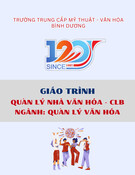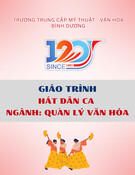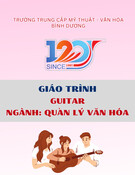
KHOA HỌC, GIÁO DỤC VÀ CÔNG NGHỆ
68 February, 2025
APPLICATION OF ATSMS QUESTIONNAIRE TO ASSESS THE
PSYCHOLOGICAL STATE AFTER TRAINING OF UNIVERSITY
STUDENTS*
Nguyen Huynh Ngoc Linha
Nguyen Thi Hanhb; Do Quang Trucc
In modern sports, besides tactics, techniques and physical strength, psychological factors play an
important role in training and competition results. The psychological state of training, whose main
components are motivation and emotion to be very diverse in terms of nuances and intensity. It can help the
practitioner feel excited, confident, full of energy and agile. On the contrary, it can also make the practitioner
feel unconfident, stressed, anxious or depressed; reactions become sluggish and slow; coordination becomes
disturbed. With the influence of psychological states on the training efficiency of the trainee being so great, it
has become an issue that sports psychology is very interested in researching. The application of the ATSMS
questionnaire to assess the psychological state after training of shooting students on the MBT03 shooting
machine at Ho Chi Minh City University of Technical Education aims to add more evidence to prove that
psychological factors play an important role in training and competition results.
Keywords: ATSMS Questionnaire; Psychology; After training; Ho Chi Minh City University of
Technical Education.
Ho Chi Minh City University of Technical Education
Email: alinhnhn@hcmute.edu.vn; bhanhnt@hcmute.edu.vn; ctrucdq@hcmute.edu.vn.
Received: 06/12/2024; Reviewed: 15/12/2024; Revised: 23/12/2024; Accepted: 03/01/2025; Released: 28/02/2025
DOI: https://doi.org/10.54163/ncdt/409
1. Introduction
In a narrow sense, sports training is “an
organized educational process that maximizes a
person’s physical and mental potential to achieve
excellent performance”. In a broader sense, sports
training is “the entire process of preparing an athlete
to create and maintain the highest level of sports
performance”. Some experts also define sports
training concept as “a planned, purposeful sports
activity under the direction of a coach to improve
performance and sports performance”.
Corresponding to the research using the ATSMS
questionnaire, however the research subjects are
different, as well as the time and characteristics
of applying the questionnaire are different, so
there will be different psychological states or
characteristics of the subjects. Based on the
requirement to improve the effectiveness of shooting
student training and contribute to improving the
understanding of the post-training state of shooting
students, so conducting the research “Application
of ATSMS questionnaire to assess the post-
training psychological state of shooting students
on the MBT03 shooting machine at Ho Chi Minh
City University of Technical Education” is very
necessary, suitable for current practice.
2. Research overview
In Vietnam today, research on sports psychology
is still very limited, with very few published
researchs, only a few initial breakthrough researchs,
such as: Research on attention concentration ability
in young table tennis players aged 11-12 and 13-
14 in Ho Chi Minh City (Quang, 2011); Research
on negative psychological states before Karatedo
competitions (Huong, 2007); Research on some
measures to adjust the psychological state before
competition of young Taekwondo athletes in Binh
Thuan province, age 15-17 (Binh, 2006); Research
on the application of POMS questionnaire to
assess the psychological state before competition
of traditional martial arts athletes in Dong Nai
province (Phat, 2015); Psychology Collection (Hac,
2002); Sports Psychology Consulting Handbook
(Toan, 2002); Sports athlete psychology (Vien &
colleagues, 2014); Research on the application of
ATSMS questionnaire to assess the post-training
status of athletes of the Vietnam traditional martial
arts team in Dong Nai province (Hanh, 2017),… In
which, only the study of author Le Thi My Hanh
mentioned the post-training state of Vietnamese
traditional martial arts athletes, therefore there
has been no research on the post-training state of
*This research was funded by Ho Chi Minh City University of Technical Education through topic, code T2024-214

KHOA HỌC, GIÁO DỤC VÀ CÔNG NGHỆ
69Volume 14, Issue 1
shooting students on the MBT03 shooting machine.
For the research of author Vu Viet Bao (2013),
the research was on the characteristics of anxiety
disorders of Karatedo athletes in Ho Chi Minh City,
the author translated and provided 15 questions
to assess the anxiety disorder status of Karatedo
athletes through the SCAT assessment, the research
assessed the level of anxiety in three levels: mild,
moderate and severe in the research subjects.
As for Research on applying POMS questionnaire
to assess the psychological state before competition
of Traditional Martial Arts athletes in Dong Nai
province (Phat, 2015), the research identified 40
questions corresponding to states including stress,
anger, fatigue, depression, enthusiasm - strength,
panic and self-related emotions.
For the research on Research on the application
of ATSMS questionnaire to assess the post-training
status of athletes of the Vietnam Traditional Martial
Arts team in Dong Nai province (Hanh, 2017), it
is also to assess the psychological manifestations
of athletes with the identification of 45 questions
corresponding to 8 psychological states including:
(1) Feelings of stress; (2) Feeling good; (3) Fatigue;
(4) Personal performance; (5) Personal regulation;
(6) Physical recovery; (7) Mental exhaustion; (8)
Mental fatigue.
Corresponding to the research using the ATSMS
questionnaire, however the research subjects are
different, as well as the time and characteristics of
applying the questionnaire are different, so there will
be different psychological states or characteristics
of the subjects.
Based on the requirement to improve the
effectiveness of shooting student training and
contribute to improving the understanding of the post-
training state of shooting students, conducting the
study “Application of ATSMS questionnaire to assess
the post-training psychological state of shooting
students on the MBT03 shooting machine at Ho Chi
Minh City University of Technical Education” is very
necessary, suitable for current practice.
3. Research methods
The research used the Chinese version presented
in the document, as: 张力为(2009), 体育科学
常用心理量表评定手册。北京体育大学出版
(Zhang Li Wei (2009)), Handbook of commonly used
psychological assessment questionnaires in sports
science (Beijing Sport University Publishing house).
The questionnaire has 45 questions with 07
levels of choice (from 0 to 6) corresponding to
never (0 to less than 2); sometimes (2 to less than
4); often (4 to less than 6); and always happens (6),
including 8 important components for psychological
assessment, including 4 positive state components
and 4 negative components, which are:
- Emotional distress: Measures the frequency of
negative moods.
- Good Feeling: Refer to a good state of physical
and mental well-being.
- Fatigue: Level of physical fatigue.
- Personal performance: Desired level of personal
performance.
- Personal regulation: The situation of using
psychological abilities when preparing for training
or competition.
- Physical recovery: Situation of physical recovery.
- Mental exhaustion: Including desire loss for
activity; physical and mental exhaustion; decreased
self-esteem; mood changes; changes in values and
beliefs; feelings of isolation.
- Mental fatigue: It is very difficult for the
practitioner to maintain a normal training state to
achieve results.
4. Research result
4.1. The relationship between sports training
and the selection of talented athletes
The competitive ability of athletes includes two
parts, one is the athlete’s genetic and innate ability;
the other is the accumulation and exploitation,
improving the premise ability of sports training.
Poor selection of sports talent will not create a
foundation for sports training; conversely, poor
and unscientific sports training will not be able to
exploit hidden talents to train them into excellent
sports athletes. In the process of forming sports
training science from the practical requirements
of training and educating sports talents, sports
training science was formed with specialized fields
such as the theory of sports competition initiated
by Matveev (former Soviet Union) on high-level
competitive sports, in which the main issues are:
(1) Competitive sport has the goal of achieving
the highest sporting achievement.
(2) The special social function of high
performance sport.
(3) The standard function of sports competition
in which the special criterion of socio-economic
and cultural value is the record of achievements that
people achieve.
(4) The function and impact of performance
sport are as great as its reward value.
(5) Social interaction function.
(6) The socialization function whose nucleus
has individual talent attributes.
In order to have high-performance sports with
valuable human-created talent, people must have
the following conditions:

KHOA HỌC, GIÁO DỤC VÀ CÔNG NGHỆ
70 February, 2025
(1) There must be athletes with outstanding
natural talent.
(2) There must be talented people with the
motivation to achieve high and the highest sports
achievements, to try their best with the highest will,
voluntarily devote all one’s mind to a profession as
a profound profession.
(3) There must be scientific and technical
guarantees as well as high quality for a professional
talent training system with a team of specialized
sports athletes.
Stimulation that create an impact on the human
biological body cause a phenomenon that Janos
Selye (Hungarian origin) calls stress. Stress in sports
is the stress caused by the amount of training and
competition that creates a monomorphic reaction
consisting of 3 stages:
(1) The first box stress multiplication stage.
(2) The reaction phase is immune and physical.
(3) The decline phase due to excessive stress
causes exhaustion. The origin of this third phase is
due to Janos Selye’s exhaustion of energy.
The three stages of stress represent adaptation
in the form of cyclical and limited waves that are
natural not only to humans. From Janos Selye, there
are two types of adaptive energy (external, easily
recognizable and recoverable and internal, with a
potential working reserve to supplement the energy
generated by consumption during work but mainly
after work). Later, biomedical experts divided
energy into 3 types, from which they divided
biological energy reserve functions into 3 types:
(1) The functional type changes from static to
dynamic state of biological reserves with synthetic
anabolic reactions predominating.
(2) The functional type of biological reserves is
to balance the reactions of two types, anabolism and
catabolism (decomposition).
(3) This type of biological reserve function is
activated under stress (high stress) and requires a
very high total value.
After in-depth research in life through
biomedicine, psychology, the adaptation process is
divided into 4 stages:
(1) Emergency stage: when the body’s function
exceeds the maximum level, it is impossible to
save energy when consuming the energy reserves
of each organ with stress causing a reaction, thus
falling into a serious state of harm due to difficulty
in control. At this time, there is no change in the
function or morphology of the organ system.
(2) Transitional phase: long-term adaptation to
rapid, positive changes in morphological function
such as genetic activation of cell structure,
increased functional capacity of the organ system
that is being affected, as well as the diffusion and
transfer of influence to related organs, synthesis of
constituent elements in biological structure such as
ambumins, nucleic acids,... the effects that cause
traces in the body are not concentrated yet and have
not yet been linked into a system, meaning that the
body is adapting itself through the emergency phase
and is adapting itself (gradually forgetting).
(3) Stabilization phase: the body’s stress
response gradually decreases depending on the level
of forgetfulness > structural changes in the body
adapt and gradually develop, thereby improving
system function, ensuring stable operation and
gradual savings.
The process of forming the above traces is stable
in structure, changing the morphology and function
gradually due to the gradual familiarization with the
stimulation and the gradual adaptation law.
(4) Refractory period: when stress intensity
increases, the stress response suddenly increases,
disrupting the normal stress response pattern. The
most important biological nature of evolution is
that humans are shown in their immune capacity.
There are natural immune capacities and adaptive
immune capacities that form new dominant forms
in biological bodies. The biological adaptation
process is divided into four stages: the mobilization
stage mobilizes immune reserves to respond to
residual stress. Recovery phase: the body’s existing
immune defenses against stress are maintained.
The recovery stage of decline is the second stage
of decline when the body continues to suffer from
high-intensity stress caused by a weakened immune
system, even a sharp reduction or paralysis of the
immune system’s functions. Recovery phase: refer
to the gradual recovery of the body’s immune and
hormonal state when stress is reduced.
4.2. Psychological state after training of
shooting students on MBT03 shooting machine
The psychological state of an athlete reflects
the content of activities and the interaction of
psychological factors in each individual in the
world of sports. Mood always affects and impacts
the performance of each individual in specific
circumstances.
4.2.1. The concept of stress mood
Stress is one of the typical manifestations of
stress that reflects the psychological state and
levels of energy and capacity response from normal
to possible exhaustion to solve tasks and impacts
from external or internal circumstances of the
active subject. According to Arunjot Singh in stress
and sports performance, stress can be defined as a
physical, mental or emotional demand that tends to
alter the body’s homeostasis. Stress is the result of
any type of pressure (it can be due to work, school,

KHOA HỌC, GIÁO DỤC VÀ CÔNG NGHỆ
71Volume 14, Issue 1
illness, marriage,...).
Maximum effort to meet energy: Energy is the
source of vitality that helps the body function.
Physical energy to ensure satisfaction for the body’s
vital activities. Spiritual energy is intended to
ensure satisfaction of the activities of spiritual life.
If the spirit is depressed, no matter how strong the
physical energy responses are, one feels weak and
unable to do anything. What we call will, desire,
longing... are all spiritual energies.
When increasing the amount of exercise with
high intensity, the subject must respond to energy by
increasing energy response by increasing anaerobic
metabolism, leading to increased blood lactic acid
(possibly from 12-25mmol/L), causing serious
endothelial instability in the direction of acidosis,
decreased pH, increased water and mineral loss.
The central nervous system is strongly affected
from many directions, causing a state of stress that
increases from normal to extreme or beyond the
athlete’s ability. In a quiescent state, an average of
5 ml of oxygen is used out of the total 20 ml of
oxygen contained in 100 ml of blood as it passes
through the capillary system of the tissues. The
remainder is bound to hemoglobin.
Maximize effort to meet capacity: An individual’s
core competencies are often understood as the
abilities that enable an individual to work effectively
in a certain field of activity. Core competencies
can be life skills, professional skills, expertise and
courage. Demonstrated competencies include: (1)
Performance results that bring high achievements;
(2) The ability to perform that activity makes it very
difficult for competitors to imitate; (3) The ability
to apply that ability to expand implementation into
many other types of activities.
In individual combat sports, it is the ability to
control attitudes and behavior under stress when
faced with adverse situations. In matches that
require the ability to master situations and actions
(against opponents of equal strength or with an
advantage), especially in the final rounds when
fatigue sets in and spreads, the level of tension
reaching its limit is often the deciding point for
the fate of the match. Therefore, in order to control
and master the situation until the last minute of the
match, sport athletes must always
4.2.2. Types of stress and levels of stress
Types of stress: Based on the response capacity
of the psychological process, it can be classified as
follows: (1) Stress in the state of emotional control;
(2) Stress in the perception of sports activities; (3)
Stress in the formation and performance of sports
movements; (4) Stress in mobilizing energy to adapt
to the amount of movement; (5) Stress in the state
of injury; (6) Stress in the state of sports illness...
The stress levels are as follows:
(1) First level (temporary adaptation disorder):
the subject accepts the stimulation of the situation
and begins to analyze and evaluate the levels of
harm and benefit of the problem. The activities of
body functions are mobilized to release energy and
capacity to respond to the impact situation.
At this level, extremely active rapid stress
responses often occur. These reactions are associated
with the process of excessive mobilization of the
body’s organ systems under sudden, new influences
from external environmental factors or from some
new form of activity. These reactions are sometimes
so strong that they cause the body to fall into a state
of temporary imbalance and maladaptation.
(2) Second level (increased general adaptive
response): Mobilization of energy and capacity
release from normal to maximum (stress from
moderate to maximum level): At this level, the
subject’s state of stress manifests itself in altered
levels of energy and capacity responses. An increase
in stress to a certain point is beneficial in helping
the subject release energy and capacity for action.
(3) Third level (sustainable adaptation): after
the general adaptive response increases sharply,
the body’s functional responses gradually decrease,
meaning that the body’s response to stimulations
does not have strong mutations as before. From the
results of Merrson’s research, it has been shown
that the adaptive techniques of the body’s functional
systems are characterized by maximum economy
and efficiency in their operation. Since the laws
of adaptation are also manifested in the training
process (physical adaptation and psychological
adaptation), so the factors of exercise quantity
gradually create a stable state of adaptation in sport
athletes.
The results of many researchs on this issue show
that, during the training process, Coaches need to
find a regular relationship between the constant
increase of stimulations during training and the
tendency to increase the athlete’s training speed
in order to maximize the body’s adaptability in the
direction of development throughout the training
and coaching process of athletes. There are 4 basic
levels of adaptation of the active subject:
Level 1: Moderate stress, adapting to environmental
conditions.
Level 2: High level stress positive adaptation.
Level 3: Excessive stress and adaptation.
Level 4: Excessive and maladaptive stress.
In sports activities, the manifestations of
changes in endothelial and functional components
are systemic and synergistic. Common sports
diseases as well as sports injuries and psychological

KHOA HỌC, GIÁO DỤC VÀ CÔNG NGHỆ
72 February, 2025
reactions are the most obvious manifestations of
stress levels. Regular exercise with appropriate
intensity, frequency and duration will effectively
strengthen, maintain health and prevent disease. On
the contrary, strenuous physical exercise combined
with prolonged poor mental health can cause
pathological changes and even death.
4.3. Conducting calibration of ATSMS
questionnaire to suit shooting students on MBT03
shooting machine
The research has synthesized from many
different documents on methods to determine
the post-training psychology of athletes, the
research has approached a number of works that
are cited and used quite a lot today such as the
ATSMS questionnaire to assess the post-training
psychological state of students of the Dong Nai
Province Shooting Team. The research has identified
the following specific implementation steps:
Step 1: Determining the psychological state
assessment scale after training for Shooting
students, proceed to localize the assessment scale.
Step 2: Consulting with experts to adjust
the original Chinese version of the scale to suit
Vietnamese language and cultural characteristics,
especially for Shooting students.
4.4. Determining the psychological state
assessment scale after training for shooting students,
proceed to Vietnamize the assessment scale
From the original Chinese version of ATSMS,
two translators will translate it into Vietnamese,
both of whom are excellent Vietnamese students
studying in China (HSK level 6 - level 8). The two
translators work independently, creating the first
two draft translations of the Vietnamese version
of ATSMS. When translating, focus on concepts
rather than literal translation to maintain common
language. After the two translators finished, we held
the first meeting, compared the two translations and
came up with the most correct version, only when
there is consensus among the research team will
the topics be properly included in the minutes. For
topics with linguistic or cultural issues, only the
translator is allowed to propose a final reasonable
choice for all, the research team decides to use the
most acceptable choice.
The consensus on the quality of the version was
assessed by experts. They were all Vietnamese, for
each item of each question, selecting appropriate
assessments with clear levels of “agree” and
“disagree”, assessing the concept and other issues,
basically agreed on the use of language. The result of
this process was the first version of the Vietnamese
version of ATSMS (T1.1).
After translating the ATSMS into Vietnamese, it
will be translated back into Chinese by two other
bilingual translators. These two translators are also
professional translators and independently complete
the questionnaire.
After the translation is completed, a consensus
is reached and a reverse version of the ATSMS is
completed. The consensus on the Chinese reverse
translation is re-evaluated by experts, finally the
Vietnamese version of the ATSMS is completed.
Through strict original inspection with all reviews
including Chinese back translation, experts evaluate
the Vietnamese version of ATSMS as follows:
The Vietnamese version of ATSMS in semantics,
idioms, experience, as well as other aspects of the
concept, using simple words, most of which achieve
the original meaning, the difficulty of translation
grammar is moderate and it has been solved; slang or
idioms have been met and converted relatively fully,
the original phrases are expressed equivalently, the
translation table uses some concepts, expressions
different from the original word instead of non-
existent or inappropriate to Vietnamese culture,
these conversions are acceptable, but should still
be through local investigation to check and adjust,
improve the influencing factors. Experts agree
that the content and meaning of the Vietnamese
version of ATSMS is equivalent to the original, the
translation is easy to understand. Completing the
translation process and test efficiency.
The Vietnamization process is specifically
shown in the following diagram:
Diagram 1. ATSMS scale Vietnamization process
4.5. Conducting interviews with experts in the
sports field to localize questions to suit Vietnamese
language and cultural characteristics.
After the two translators agreed on the draft of
ATSMS (The development of the Athletic Training
State Monitor Scale), the research conducted
interviews with 11 experts in the field of sports to
evaluate and adjust the Vietnamese translation of the
ATSMS
chinese
Version
Translating
back to
Chinese
Inify the draft
Independent
translation
Unify
ATSMS table
(1.1)
Expert review
(China)
Unify draft Expert review
(Vietnam)
Completing
ATSMS

![Tài liệu Các phương pháp nghiên cứu lịch sử văn minh thế giới [chuẩn SEO]](https://cdn.tailieu.vn/images/document/thumbnail/2025/20250915/ntnl251206@gmail.com/135x160/4281757904768.jpg)


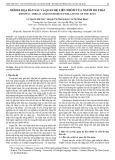
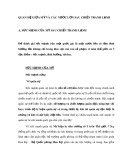
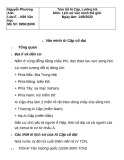
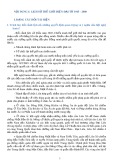
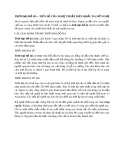

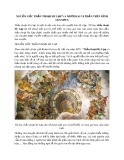
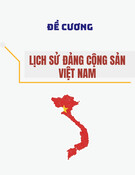
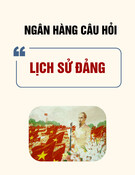

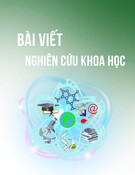


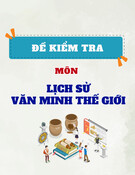
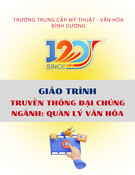
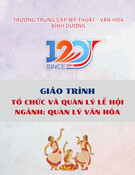
![Giáo trình Tổ chức và Quản lý Hoạt động Văn hóa Thông tin Cơ sở (Ngành Quản lý Văn hóa - Trung cấp) - Trường Trung cấp Mỹ thuật - Văn hóa Bình Dương [Mới nhất]](https://cdn.tailieu.vn/images/document/thumbnail/2025/20251110/kimphuong1001/135x160/17861762748492.jpg)
